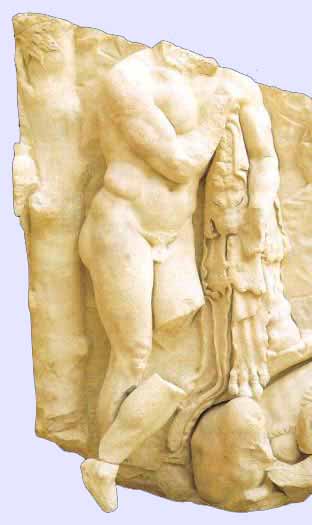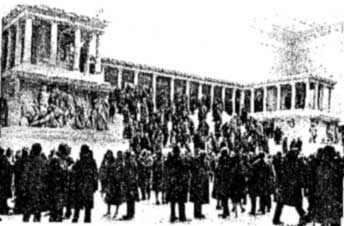.
The gigantomachy frieze marks the climax of Greek sculpture, Roger Ling

Part of the Pergamon Acropolis, with the altar of Zeus with a horseshoe shape, designed by Menecrates of Rhodes.
The Altar of Zeus was constructed by Eumenes II (197-159 BC) and after his death by Attalus II as a memorial of the victory against the Galatians and taking the Acropolis of Athens as an example. Its dimensions are 36.4 x 34.2 m. It is composed of four parts and the high relieves on it describe the war between the giants and the gods.
The altar was constructed in the period 166-156 BC, although it was not completely finished. (around 156 BC king Prusias II attacked Pergamon).
The frieze sculptures show the fight of the gods, who finally are victorious, against the giants (gigantes) (Gigantomachy). The giants (around 100) are the sons of the mother Earth Gaea (or Gaia). It is a victory finally by Zeus over Gaea and in this way he ends the matriarchal epoch and establishes a patriarchal government order and culture. Maybe this transition is due to a period where man developed and advanced the technology of war.
Historians consider Phyromachos of Athens as one of the leading sculptors of the Zeus Altar. The giants are naked, with human shape, sometimes winged with a lizard like tail, their faces full of pain whereas the gods faces are relaxed showing their superiority. The giants birthplace is Pallini in Chalkidiki in Greece. In the Altar a Gigantomachy is shown with 34 goddesses, 20 gods, 59 giants and 28 animals (serpents, dogs, horses, the flying steeds of Zeus, mules and lions). The names of the gods are chiseled at the cornice, while the giants' names are chiseled on the pedestal next to the names of the sculptors. Among the many gods there are in principle also two humans (or semi-gods), Dionysus and Herakles (Hercules). One can understand the Gigantomachy to represent a fight between the rational behaviour represented by the gods and the raw immoderate Nature represented by the giants. The victory represents a metamorphosis of a barbaric world to a more civilized. Important is that the gods could not win the fight until Zeus asked Dionysus and Herakles to participate in the battle. The Pergamon Altar is one of the most impressive pieces of Art from Europe. Byzantine conquerors tore down the altar in the eighth century A.D. and used the marble as building material for a wall. The slabs from the magnificent frieze, from many mostly unknown artists (some sources say a work of up to 40 sculptors with 15 signatures found), remained embedded in the wall until thousand years later a German engineer, Karl Humann, discovered the altar. He described how pieces where taken to be destroyed in order to produce material for new buildings in the region. He succeeded to save this important piece of Hellenistic civilization from destruction. Recently Silvano Bertolin and his group after 8 years work again restored the approximately 120 meter frieze and were able to include some missing parts.
Numerous uprisings against the Turks as well as the war between Turkey and Russia had worked in favor of the young German Empire by increasing its influence with the Ottoman Empire. Permission to excavate at Pergamon was obtained easily. The division of finds originally agreed upon between Turkey and Berlin was renegotiated with Bismarck’s support in 1878-1879. The new agreement stated that in exchange for 20,000 Marks, the Turkish government would permit all finds relating to the Pergamon Altar to go to Berlin. Max Kunze, The Pergamon Altar: Its Rediscovery History and Reconstruction (Museum Guide). Mainz am Rhein: Staatliche Museen zu Berlin Preußicher Kulturbesitz Antikensammlung, 1995.
Some figures of the Zeus altar are Gauls and the altar is also used to celebrate the victory of Pergamon against the Gauls.
Image of Karl Humann 4.1.1839 (Steele) - 12.4.1896 (Smyrna)
The Pergamon frieze is the largest sculptural composition after the famous Parthenon marbles of Athens--now in the British Museum, though it was carved with much larger figures (7.5 feet). By depicting the victory of the Greek gods over the giants, the altar symbolically celebrated the triumph of the city of Pergamon in the newly conquered lands of Anatolia, hence proclaimed the city as the legitimate continuation of the Greek civilization, a second Athens located far from the mainland Greece. This indeed suggests that Pergamon, a city governed by a Greek speaking elite, yet consisting mostly of Lydian natives, referred to classical Athens (5th century BC) as the origin of its own high culture. S.M. Can Bilsel, Zeus in Exile: Archaeological Restitution as Politics of Memory

Probably the Hercules of the Telephos Frieze, from the Pergamon Zeus temple, is a work that is based on the resting Hercules of Lysippos. (Berlin Germany Inv. No. T.I.17 Staatliche Museen Preussischer Kulturbesitz). Right a part of a lioness and the infant Telephos .(Usually the story is that the infant Telephos is suckled by a deer but a lion was selected an animal stronger than the wolf of Remus and Romulus, a provocation for the Romans who secretely supported the attacks of the Galatians. )

Opening of the Pergamon Museum 22 April 1929

The frieze sculptures of the Zeus Altar, an example of Hellenistic Baroque:
Fight of the important (mainly) Olympian gods
Fight of the gods of the firmament and of light
Fight of the fates and gods of revenge
Fight of the gods of the sea (the west side faces to the sea direction)
Another second frieze illustrates the life-history of the mythical founder of Pergamum, Telephos, a son of Herakles (Hercules) and Auge a priestess of Athena Alea at Tegea.
In choosing to honor Heracles as the hero in the frieze, the Attalids identified themselves even more closely with Greek tradition, for, according to their mythology, the city of Pergamon was founded by Telephos, the son of Heracles. To commemorate this event, the Attalids set another frieze – smaller and less tempestuous than the outer one – within the sanctuary high on the top of the altar. This smaller frieze tells the story of the virgin priestess Auge, raped by Heracles and condemned by her father, manages to give birth to Telephos and hide him in a thicket before she is put out to sea in a boat. Telephos, suckled by a doe, is later rescued by Heracles and while traveling far and wide in search of his mother, founds the city of Pergamon. Most of this frieze was also uncovered by Humann and sent to Berlin. Smithsonian
If we compare the Pergamene altar-frieze with scenes of combat from the best period of Greek art, say with the metopes of the Parthenon or the best preserved frieze of the Mausoleum, we see how much more complicated and confused in composition and how much more violent in spirit is this later work. Yet, though we miss the "noble simplicity" of the great age, we cannot fail to be impressed with the Titanic energy which surges through this stupendous composition. The "decline" of Greek art, if we are to use that term, cannot be taken to imply the exhaustion of artistic vitality. F.B. Tarbell
S.M. Can Bilsel, Zeus in Exile: Archaeological Restitution as Politics of Memory , Center for Arts and Cultural Policy Studies, Princeton University, Working Paper #13, Fall 2000
From Pergamon to Sperlonga: Sculpture and Context (Hellenistic Culture and Society)- by Langford Conference of the Department of Classics 1997 Florida State (Corporate Author), Nancy Thomson De Grummond (Editor), Brunilde Sismondo Ridgway (Editor) University of California Press ( 2001) ISBN: 0520223276
| Ancient Greece
Science, Technology , Medicine , Warfare, , Biographies , Life , Cities/Places/Maps , Arts , Literature , Philosophy ,Olympics, Mythology , History , Images Medieval Greece / Byzantine Empire Science, Technology, Arts, , Warfare , Literature, Biographies, Icons, History Modern Greece Cities, Islands, Regions, Fauna/Flora ,Biographies , History , Warfare, Science/Technology, Literature, Music , Arts , Film/Actors , Sport , Fashion --- |

